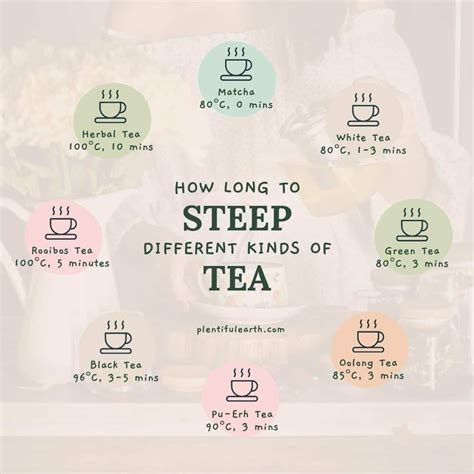How Long to Steep Tea: A Guide to the Perfect Cup
Steeping tea seems simple enough, but getting the perfect cup involves more than just tossing a bag in hot water. The ideal steeping time varies dramatically depending on the type of tea and your preferred strength. This guide will help you master the art of steeping and unlock the full flavor potential of your favorite blends.
Understanding Tea Types and Steeping Times
Different teas require different steeping times. Over-steeping can lead to bitterness, while under-steeping results in a weak, flavorless brew. Here's a general guideline:
Black Tea:
- Steeping Time: 3-5 minutes
- Water Temperature: 200-212°F (93-100°C)
- Notes: Black teas are robust and can handle a longer steep, but avoid overdoing it. Experiment to find your preferred strength. Popular varieties like English Breakfast and Earl Grey benefit from this longer steep time.
Green Tea:
- Steeping Time: 1-3 minutes
- Water Temperature: 160-180°F (71-82°C)
- Notes: Green teas are delicate and easily become bitter if over-steeped. Using water that's too hot will also scorch the leaves, ruining the flavor. Sencha and Gyokuro are particularly sensitive to temperature.
White Tea:
- Steeping Time: 1-2 minutes
- Water Temperature: 170-180°F (77-82°C)
- Notes: White teas are among the most delicate, requiring the shortest steeping time and lower water temperature. Silver Needle and White Peony are exquisite examples.
Oolong Tea:
- Steeping Time: 2-5 minutes (varies greatly by oxidation level)
- Water Temperature: 185-205°F (85-96°C)
- Notes: Oolong teas encompass a wide spectrum of oxidation levels, impacting steeping time. Lighter oolongs (like Tieguanyin) need shorter steeping times, while darker oolongs (like Da Hong Pao) can tolerate longer steeps.
Herbal Infusions (Tisanes):
- Steeping Time: 5-10 minutes
- Water Temperature: 212°F (100°C)
- Notes: Herbal infusions aren't technically "tea" as they don't come from the Camellia sinensis plant. They generally benefit from longer steeping times to extract maximum flavor. Chamomile and Peppermint are excellent examples.
Factors Affecting Steeping Time
Beyond tea type, several other factors influence optimal steeping time:
- Leaf quantity: More leaves generally require a slightly shorter steeping time to prevent bitterness.
- Water quality: Using filtered water ensures cleaner flavor and prevents mineral buildup affecting taste.
- Altitude: Higher altitudes require slightly longer steeping times due to lower atmospheric pressure.
Tips for Perfect Steeping
- Use a timer: This ensures consistent results.
- Start with the shorter end of the recommended time: You can always steep longer, but you can't un-steep.
- Experiment: Find your personal preference for strength.
- Discard used leaves: Don't re-steep leaves for the best flavor.
- Proper Teaware: Invest in a quality teapot or infuser to enhance your tea experience.
Conclusion: Brew the Perfect Cup
Mastering the art of steeping tea takes practice, but with this guide, you’ll be well on your way to brewing the perfect cup every time. Remember to always consider the type of tea and adjust your steeping time accordingly for the most delightful experience. Happy steeping!
